I am of the firm opinion that when it comes to the worlds of Star Wars, the best moments come not from the blockbuster films but from expanded universe creations that have taken the world-building of the main Skywalker Saga and opened the door to an explosion of plots, themes, motifs, characters and more.
I would further argue that some of the most developed and fully fleshed-out characters come not from the official film canon, but from the combination of animated series released pre-Disney takeover and live-action selections currently airing on Disney+. The live-action shows like The Mandalorian, Andor, The Book of Boba Fett and Obi-Wan Kenobi combine familiar favorite characters from the films with new creations, as well as lifting from the early animated show Star Wars: The Clone Wars.
It can be daunting for a new or casual fan to look at the list of current Star Wars offerings and know where to start—or even if they should attempt to tackle the behemoth of media that this franchise represents. There are plenty of watch guides available online that will orient viewers to a specific chronology, character or theme, but even so, I fully believe that for most casual fans, there’s simply too much going on.
In my opinion, watching Star Wars is a journey, and it changes for me every time I go through it. I watch the saga differently each subsequent time I return to a galaxy far, far away. And in light of the upcoming show Ahsoka (expected August 2023), I want to share my current Ahsoka Tano prep list.
Who is Ahsoka Tano?
First, allow me to introduce one of my all-time favorite characters of any franchise, Ahsoka.
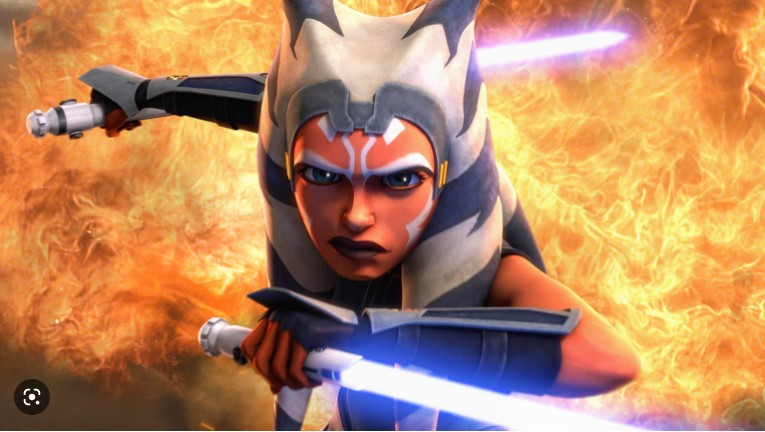
Appearing first in the animated film Star Wars: The Clone Wars (2008), Ahsoka Tano is introduced as Anakin Skywalker’s newly assigned Padawan learner. Yoda feels the calming influence of instructing a Padawan will help hone Anakin’s impulsive behavior and enhanced abilities.
It’s not a bad movie, and you can certainly start your dive into Star Wars with it, but I don’t necessarily think the rest of the material showcased within changes the context of what follows. Instead, the movie launched an animated show by the same name, written and directed by showrunner Dave Filoni, whose name should ring some major bells in current Star Wars fans’ heads (he will be writing/directing Ahsoka and has writing or directing credits on many major Star Wars projects). The animated film introduces his version of events, opening up the clone wars beyond the purview of the live-action movies Attack of the Clones and Revenge of the Sith.
There’s a reason to center Ahsoka in this particular watch-through and ahead of her own series. I hold the opinion that Ahsoka remains the narrative foil to the Skywalker clan, embodying and representing the lived ideal of the Jedi Order while managing to be separate from the institution itself. Her journey mirrors that of Anakin’s, but her choices consistently return her to the light as she attempts to hold back the tide of the Empire.
So, with the 2008 film introducing who Ahsoka Tano is and why she is attached to Anakin Skywalker, I can offer my suggested watch order. I recommend this order for both those new to the worlds of Star Wars and those who find a familiar home in the stories and characters brought to life within. I’m calling this The Ahsoka Tano Timeline. It condenses seven seasons of The Clone Wars and four seasons of Rebels into a streamlined chronology.
The Ahsoka Tano Timeline
Film: Star Wars Episode I: The Phantom Menace (1999)
OK, I hear you, The Phantom Menace is not a good entry in the Star Wars lexicon, but remember the intended audience. Take the film for what it is, a campy kids’ space opera about a rising evil and the forces of good that have to meet it. It introduces the major plots and themes in the worlds of Star Wars and is chronologically the first place in the timeline (for television and films, not books). Also, the lightsaber duel between Darth Maul, Qui-Gon Jin and Obi-Wan Kenobi is perhaps the best choreographed duel in the entire series and has the best background music. The death of Qui-Gon Jin at the end (Look, if you’re upset about that spoiler, I’m going to remind you it’s been nearly 24 years since the movie premiered) allows for Obi-Wan’s promotion to Jedi Knight. This moment is perhaps slightly difficult to follow, as Qui-Gon had spent some time in the film trying to take Anakin Skywalker on as a Padawan, an apprentice. He is denied the request while his current Padawan Obi-Wan remains a learner. When Obi-Wan is promoted, he, in turn, becomes eligible to take on an apprentice of his own.
Why start here? Because it’s the chronological beginning. Knowing Anakin is central to knowing Ahsoka, and seeing his path to becoming a Padawan, as well as Obi-Wan’s rise to full Jedi Knight, allows audiences to understand the hierarchy of the Jedi order. The emphasis placed on education is evident: it is the job of established Jedi Knights to teach the young.
Find a copy of Star Wars, Episode I: The Phantom Menace
Alternatively, you could just enjoy this incredible scene:
Film: Star Wars Episode II: Attack of the Clones (2002)
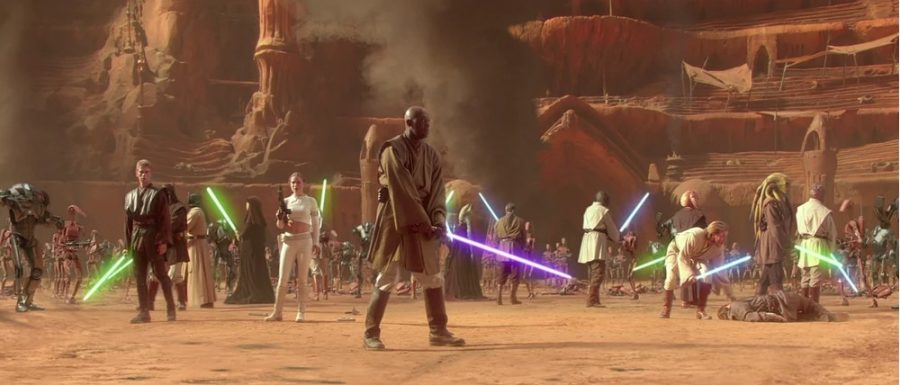
This film serves as the introduction to the titular Clone Wars, providing the key players and contexts necessary to understand the animated television series. Set a decade after the first film, Anakin is still a Padawan, though he is approaching the time to take his Trials and graduate to full Jedi Knight. The film concludes with the first battle of a galaxy-spanning war, sets the stage for the fall of the Republic, and gives audiences a glimpse into the formation of the Empire that is already so well-established in the original trilogy.
The film also introduces key relationships between characters, which will be explored and developed in depth in the various television series, namely, the marriage of Anakin Skywalker and Senator Padmé Amidala. Now, it isn’t necessarily clear to the casual watcher that the Jedi have a very strict code that precludes marriage. Attachments are forbidden to the Jedi, and that includes love, romance, marriage and everything else that goes along with it.
Find a copy of Star Wars, Episode II: Attack of the Clones
Animated Series: Star Wars: The Clone Wars (2008–2020)
Now we get to the bulk of Ahsoka’s story and some of the best episodes in Star Wars of any kind. Keep in mind, especially if you choose to watch the show in the order it aired, that the show starts as a children’s show. Many early episodes and even a handful of episodes in the later, much heavier, seasons cater primarily to a child’s attention span and interests. This isn’t to say the episodes are throw-aways or of little value to an adult, but I think many people begin the series expecting the darkness of the final season, and that’s just not the intention of this show.
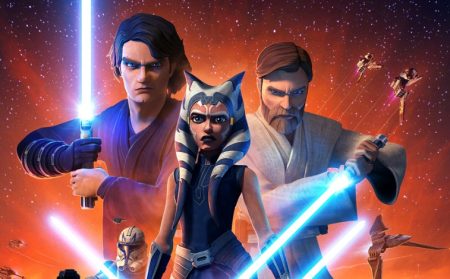
Over the course of seven seasons, The Clone Wars builds in darkness and intensity to reflect the rising power of the Empire, a mysterious entity that is largely unknown by the residents of this universe. The series spans about three years of in-universe time, situating itself directly between the films Attack of the Clones and Revenge of the Sith, whose opening scene happens concurrently with the show’s final action sequence. There’s a lot to wade through and so many different angles to take, but I’ve chosen a chronological guide to Ahsoka’s life, so there’s a fair bit of jumping around.
Without further adieu, we begin with a few episodes from season one, when Ahsoka is approximately 14 years old:
- Season 1, Episodes 2–4: Ahsoka, as Padawan to Anakin, assists the Republic in attempting to capture the warship Malevolence and the duplicitous General Grievous, whose capture could end the war quickly.
- Season 1, Episode 9: Ahsoka spends time with a different Jedi Master, transporting a war criminal back to stand trial.
- Season 1, Episodes 13–14: While her Master is injured, Ahsoka must work with another Jedi to care for the war’s wounded while on a neutral planet whose allegiance must be won.
- Season 1, Episode 19: While under Ahsoka’s command, many clone troopers die in a failed assault. She must learn how to process defeat while continuing the war efforts.
- Season 2, Episodes 1–3: The information gathered here regarding the function of the Jedi begins to illuminate the problems endemic to the Order, problems that might lead to their eventual downfall.
- Season 2, Episode 17: While Ahsoka, Anakin and Obi-Wan defend a planet from Bounty Hunters, the dynamic between the three characters is established clearly and begins to develop here. As Anakin’s mentor, Obi-Wan feels a natural closeness to Ahsoka, but she is Anakin’s student through and through.
- Season 2, Episodes 6–8: Returning to Geonosis, the planet which launched the clone wars in Attack of the Clones, Ahsoka works with another Padawan to untangle dark secrets and plots, attempting to halt weapons production by the enemy.
- Season 2, Episode 11: Ahsoka loses her lightsaber, the most important tool for a Jedi, and must retrieve it before it’s too late.
- Season 3, Episodes 5–7: Ahsoka spends time first on Mandalore, attempting to uncover a devious plot, and then in Senator Amidala’s retinue after Ahsoka’s visions of the future indicate Padmé’s life is in danger. We see here both Ahsoka’s growing relationship with the Force, but also her relationship with Padmé. While it’s never expressly clear if Ahsoka or Obi-Wan figure out about Anakin’s relationship with Padmé, both his student and his former teacher exhibit a degree of closeness with Senator Amidala absent from her other Jedi relationships. It is clear in Episode 7 particularly that Padmé treats Ahsoka as a close and respected member of her party, perhaps blurring the line between the formal and the familial.
- Season 3, Episode 4: Ahsoka volunteers for a rescue mission
- Season 3, Episode 10: Once more, Ahsoka joins Padmé for a mission. She meets a young boy of similar age and has a brief experience with flirtation and first crushes. But Ahsoka is not a normal 14 (or maybe 15 by now) year old; she is a Jedi, for whom attachments are anathema and her crush could never blossom. It’s a hard lesson to learn.
- Season 3, Episodes 15–17: a 3-part arc that establishes Star Wars Jedi lore which remains canon to this day and is vitally important to the direction of Star Wars media. While the bulk of the story reveals more about Anakin, the world-building here comes back to Ahsoka’s story further down the road.
- Season 3, Episodes 21–22: kidnapped as part of a plot reminiscent of The Most Dangerous Game, Ahsoka must work with other young Jedi to escape
- Season 4, Episodes 1–4: Ahsoka’s skills as a fighter and tactician are developing as she attempts to keep the planet Mon Calamari safe from a Separatist attack.
- Season 4, Episodes 11–14: An investigation into a missing colony reveals a group of slavers operating within the Republic; Ahsoka, Obi-Wan and Clone Commander Rex go undercover to root out the problem; Ahsoka is brought face to face with her crush from S3E10 as the fall-out from that plot continues through to present day
- Season 5, Episodes 2–5: this arc features Ahsoka taking a leadership role and making choices distinct from those of the Jedi order, remaining to train a group of rebel freedom fighters and experiencing the war from the point of view of average citizens rather than as a Jedi General. This arc makes her confront the growing flaws housed inside the Republic and the Jedi order as she grapples with the difference between doing the right thing and following orders.
- Season 5, Episodes 6–9: Ahsoka, at Yoda’s request, helps a group of younglings construct their first lightsabers. Though she is only about 16 by this point, she’s growing to adulthood, and her role as a teacher is expanding with Yoda’s guidance.
- Season 5, Episodes 17–20: Perhaps my favorite of Ahsoka’s arcs, when Ahsoka is accused of treachery, she must do everything in her power to clear her name. However, that her word and her honor are not enough to clear her name on their own, Ahsoka begins to realize how deeply the flaws of the Jedi order run and realizes there must be a significant change if she is to continue.
- Season 6, Episodes 6–8: Ahsoka is no longer a Jedi Padawan, but she still wants to make a difference for good in the war effort. This arc introduces new characters and new players but also gives Ahsoka (and audiences) new perspectives on the war. The Clone War has been largely witnessed through the eyes of the highest echelon of government in the universe of Star Wars, and now Ahsoka must confront the reality of war on the common people.
- Season 7, Episodes 9–12: the finale for the entire show, Ahsoka’s perspective on the events leading up to and concurrent with the film Revenge of the Sith. Buckle up, especially if you’re soft-hearted. My heart broke during this sequence.
Find a copy of Star Wars: The Clone Wars
Animated series: Star Wars: Rebels (2014–2018)
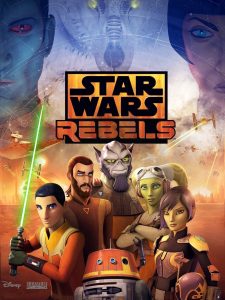 Rebels is, hands down, my all-time favorite piece of Star Wars media when taken as a whole. While the bulk of the story itself is not about Ahsoka, she intersects with the plot often enough, and in staggeringly important ways. I think, based on the teaser trailer for Ahsoka, that her show will be following some unanswered questions and hanging plotlines left ambiguous at the end of Rebels. This makes my chronological watch list quite difficult because I don’t want to overwhelm new fans with five seasons of a show whose characters and major story arcs have, as yet, only minorly come to fruition on the silver screen. I suggest watching the entire run of the show from start to finish; it appears chronologically, unlike The Clone Wars, and the focus is much smaller, following one specific group of rebels pushing back against the rising Empire. It’s set in the years following Revenge of the Sith, filling in some of the 19-year gap between Revenge and A New Hope. For a more abbreviated version of important events centralizing Ahsoka, I recommend watching:
Rebels is, hands down, my all-time favorite piece of Star Wars media when taken as a whole. While the bulk of the story itself is not about Ahsoka, she intersects with the plot often enough, and in staggeringly important ways. I think, based on the teaser trailer for Ahsoka, that her show will be following some unanswered questions and hanging plotlines left ambiguous at the end of Rebels. This makes my chronological watch list quite difficult because I don’t want to overwhelm new fans with five seasons of a show whose characters and major story arcs have, as yet, only minorly come to fruition on the silver screen. I suggest watching the entire run of the show from start to finish; it appears chronologically, unlike The Clone Wars, and the focus is much smaller, following one specific group of rebels pushing back against the rising Empire. It’s set in the years following Revenge of the Sith, filling in some of the 19-year gap between Revenge and A New Hope. For a more abbreviated version of important events centralizing Ahsoka, I recommend watching:
- Season 1, Episodes 8–9: introduces the characters and major plots, gives enough context to skip around the show without losing track of what is going on
- Season 1, Episodes 13–15: the finale for season one raises stakes, increases the intensity and introduces an adult Ahsoka, who is approximately 31.
- Season 2, Episodes 1–2: Ahsoka senses something about the black-clad enemy now chasing them
- Season 2, Episode 10: Ahsoka appears to assist the crew to protect force-sensitive children. She also reveals her investigation into the mysterious Darth Vader, who audiences know is Anakin Skywalker, post-fall to the Dark Side, but characters in the show don’t yet know this (with perhaps the exception of Obi-Wan and Yoda, who saw recordings at the Jedi temple).
- Season 2, Episode 18: Ahsoka’s journey to a derelict Jedi temple in search of answers fills in some more Jedi lore, including revealing her former Master’s fate
- Season 2, Episodes 21–22: the season two finale brings Ahsoka face-to-face with her former Master for the first time in fifteen years. It will absolutely tear your heart out, both for Ahsoka, but also for Anakin. This sequence gives such depth to Anakin/Vader. She disappears at the end of this episode and is presumed dead
- Season 4, Episode 13: We learn what happened to Ahsoka at the end of season two and travel to my favorite weird place in Star Wars, the World Between Worlds.
- Season 4, Episodes 15–16: The series finale and imperative watching before the new Ahsoka show. The question of Ezra Bridger’s fate at the end of the series is the biggest unanswered question currently in Star Wars, and Ahsoka intends to answer it.
Find a copy of Star Wars: Rebels
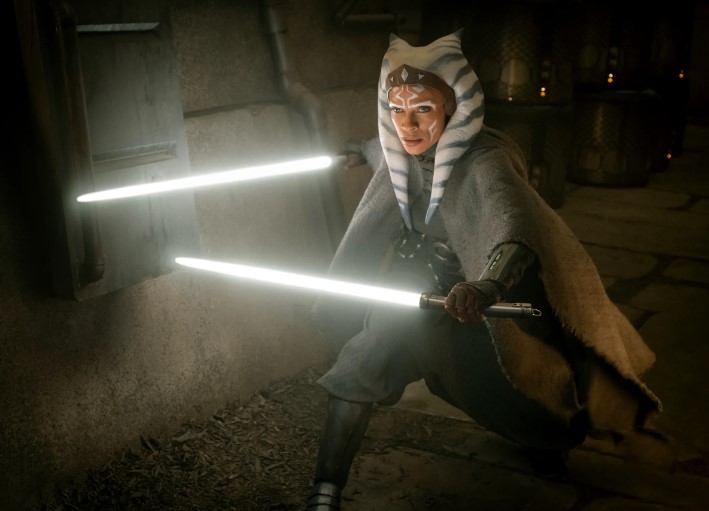
Live Action Series: The Mandalorian (2019–)
The series jumps forward in time, bypassing the original trilogy movies (A New Hope, The Empire Strikes Back and The Return of the Jedi) and beginning about five years after the final movie. Mostly the series follows the titular Mandalorian on his journey, but as the show has continued, it has opened up to more characters, plotlines and heavy implications about the world of Star Wars as a whole. The show also gives us Ahsoka’s first live-action appearance. Ahsoka doesn’t show up until the second season, but her appearance won fans over. Her only appearance is in season 2, episode 5, but it’s definitely worth a watch as Rosario Dawson brings such a beautiful gravitas to this fan-favorite character, embodying a roughly 45-year-old Ahsoka in her search for Thrawn.
Watch The Mandalorian with one of our Rokus
Live Action Series: The Book of Boba Fett (2021)
I love The Book of Boba Fett as a stand-alone entry in the Star Wars cinematic universe. As a character, Boba is infinitely fascinating, and I think his arc got some fantastic justice here. However, in season 1, episode 6, the focus shifts away from Boba and to the Mandalorian and Ahsoka.
Watch The Book of Boba Fett with one of our Rokus
Live Action Series: Ahsoka (Coming Soon)
This brings us current with Ahsoka’s timeline, and now we must wait till August for her continuation. I, for one, can hardly wait. Ahsoka’s development throughout her various appearances is poignant and gorgeous. As she struggles with the Jedi Code in the face of rising hypocrisy, so too do we watch Anakin struggle in the course of the main Skywalker Saga. But where Anakin consistently chooses incorrectly, prioritizing his feelings over everything, Ahsoka learns to temper her emotions with wisdom, to guide with empathy borne of love, not distance. As a character, she is incredibly developed. Her flaws are part of her character rather than detractions. And though she isn’t actually a human (she’s a species called Togruta), she is perhaps the most human character in the entire universe because her complexity brings her to life beyond the screen. She feels real to me. I love Ahsoka Tano, and I hope you will, too.
